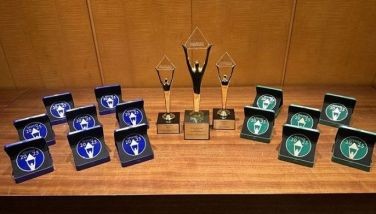The Manila FAME

The recent Manila FAME showcased the bold, the new and the beautiful in Philippine handicraft, jewelry, fashion and furniture.
Every year for over five years now, we have been following this trade show and have seen for ourselves how they have evolved into one extraordinary world-class exhibit. Even during the time of Ms. Mina Gabor, CITEM (Center for International Trade & Exposition Missions) always managed to outdo itself every year, and we marveled at the design genius, the craftsmanship of the Filipino artisan.
This year’s show, with Budji Layug as creative director, Anton Mendoza as creative consultant, Josie Natori as creative director for fashion, and Kenneth Cobonpue as Star designer, featured some novel ideas. Juan Luna art works were juxtaposed with modern furnishings for instance, a first for this show, and perhaps inspired by Yolanda, the Butterfly House was set up right by the entrance. It is made of hard clear plastic, a see-through modular house that is entirely collapsible in case of storm warnings and is supposedly ideal for areas prone to typhoons like those in the Eastern Visayas. The organizers say that it is a better alternative to tents, which may be true as far as aesthetics and space are concerned, but as a temporary shelter while construction of one’s house is on-going, the Butterfly House begs too many questions against practicality and cost vis-à -vis a simple, sturdy, space-saving tent.
Some exhibitors from the devastated region came but we were told that, like in the October show, they did not come in full force. One that our crew chatted with, the sales person for Cassandra Enterprises from Bohol, said that the owners bravely went through the production of fashion accessories despite the severe shortage of raw materials among other challenges. This is the second time they are joining FAME, and they are only allowed two chances of joining, so they had to mobilize their deflated resources, hoping to maximize the benefits of the show to their advantage. Made mostly of wood like langka, their bangles and necklaces were exotic and colorful.
Grand as the recent show was, CITEM has seen better days. The genius of design and exquisite craftsmanship of the Filipino are still the hallmarks of Manila FAME, but it is the global market and the consumer attitude that have changed dramatically. According to Ms. Rosie Gaetos, executive director of CITEM, they used to make as much as $50 million as on-the-spot sales for a show, but this year, they are hoping to get $25 million. For last year’s two FAME shows (one in March and the other in October 2013), the figure sat at $35 million.
There was a booth for FOBAP (Foreign Buyers Association of the Philippines) at the show which is a most vital one for exporters. The foreign buying offices represent the biggest buyers out there, especially in the United States which remains as our top buyer. Ms. Gaetos reminisced: “there used to be a time when they (the foreign buyers) came in droves…wala na yun, the market has changed totally.†In the past FAME shows, during its heyday, they used to have serious 3,000–4,000 buyers coming to Manila to place their orders. “Now we are realy feeling the pinch…we are lucky if we can get a thousand buyers,†Ms. Gaetos rued.
But such is the export market. For a time, China ruled some of the sectors here, including garments and furniture mainly because of their cheap labor. Never mind if quality was sacrificed in favor of mass production — it was a price-driven market for so many years, and it still is. Because we did not have the economy of scale, our infrastructure and logistics support are not adequate, and the labor cost in the Philippines is higher than most in the region, the Philippines was slowly relegated to a niche market of high-end specialty selections over the years. But of course, that is not where the money is.
But now, Bangladesh and Cambodia have emerged as the new manufacturing capitals of the export world, and China has fell victim to its own rising economy. This suddenly wealthy and cash-infused country now grapples with rising labor costs so that garments manufacturers here have relocated to Bangladesh.
Our problem is still with the US quota for garments, and while the private sector is trying hard to resurrect the SAVE ACT in the United States, Bangladesh and Cambodia are cornering the garments orders. In Cambodia for instance, Ms. Gaetos tells us, the Polo brand of shirts is made there, but the finished products, in bulk, are plain and without embellishments. For these embellishments, they are brought to the Philippines to finish.
For a bit of good news, one of the biggest garments exporters here (I forgot the name) has brought in the brand Coach to Tarlac.
Now for furniture. They had some of the most exquisite designs at the show this year, and I am sure the world is sitting up to take notice. Our FAME show came in the heels of two other furniture shows in the region — Indonesia and Singapore, so Manila should be their last stop, which augurs well for our furniture makers from Pampanga, Cebu and Manila that made up this year’s CFIP (Chamber of Furniture Industries of the Philippines) part of the trade show, and this Ms. Joy Cancio, CFIP Corp. Sec. proudly declares.
Like Manila FAME, we at B&L have been following the local furniture industry, so it came as no surprise to us when Nicholas de Lange, CFIP President said that 70 percent of their total production goes to the domestic market. It’s about time that our local contract market is now shifting towards locally-manufactured furniture. This includes the resorts, hotels and rapidly rising property market (residential/office condominiums. Ours may not be a cheap as China’s mass-produced furniture, but for high-end hotels and resorts, those will simply not do. Plus, in case of repairs or replacements for instance, having them right here is less of a problem.
For now, however, the furniture makers are not only looking at the domestic market, they are taking a second look at the regional market as well. We may all be Asians, but there are marked differences among our tastes, and the ASEAN market is now proving to be a fertile ground for our furniture makers on the high-end market.
Mabuhay!!! Be proud to be a Filipino.
For comments (email): businessleisure-star@stv.com.ph / sunshine.television@yahoo.com
- Latest
- Trending


























